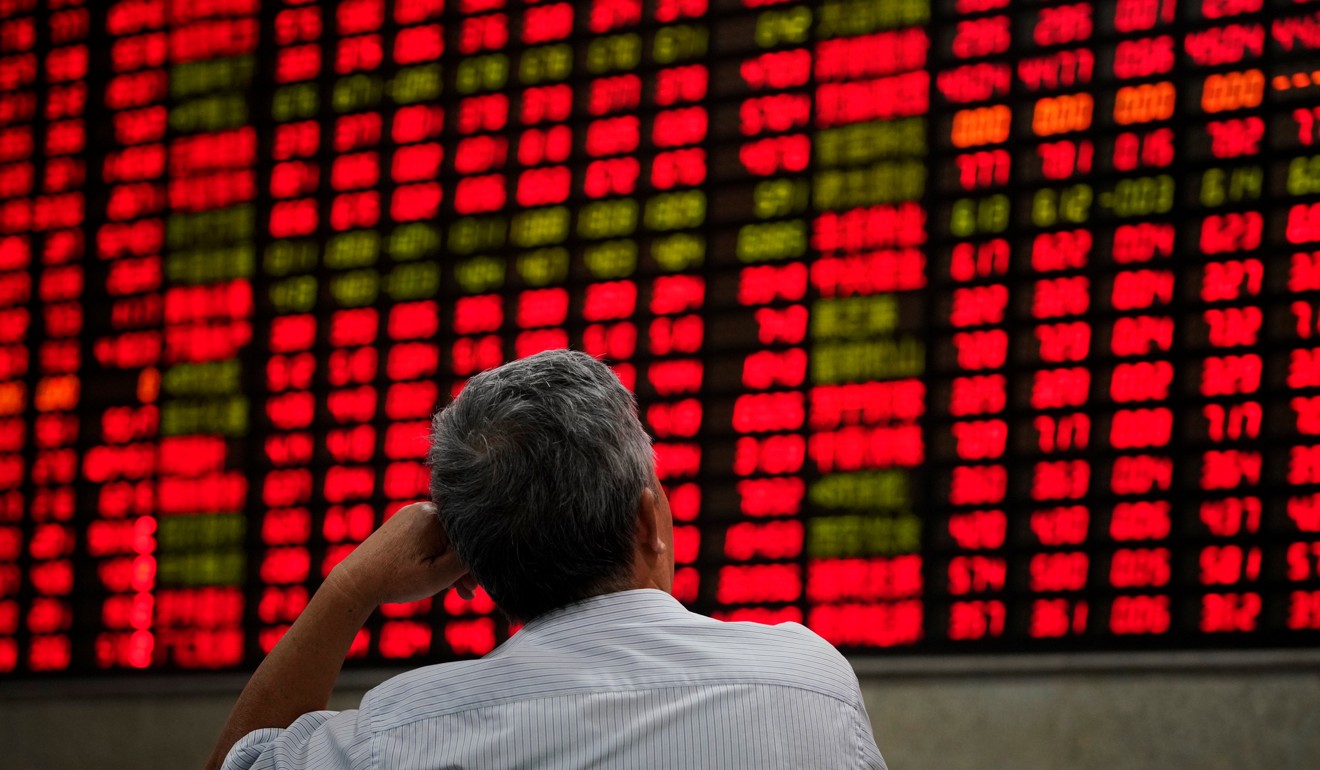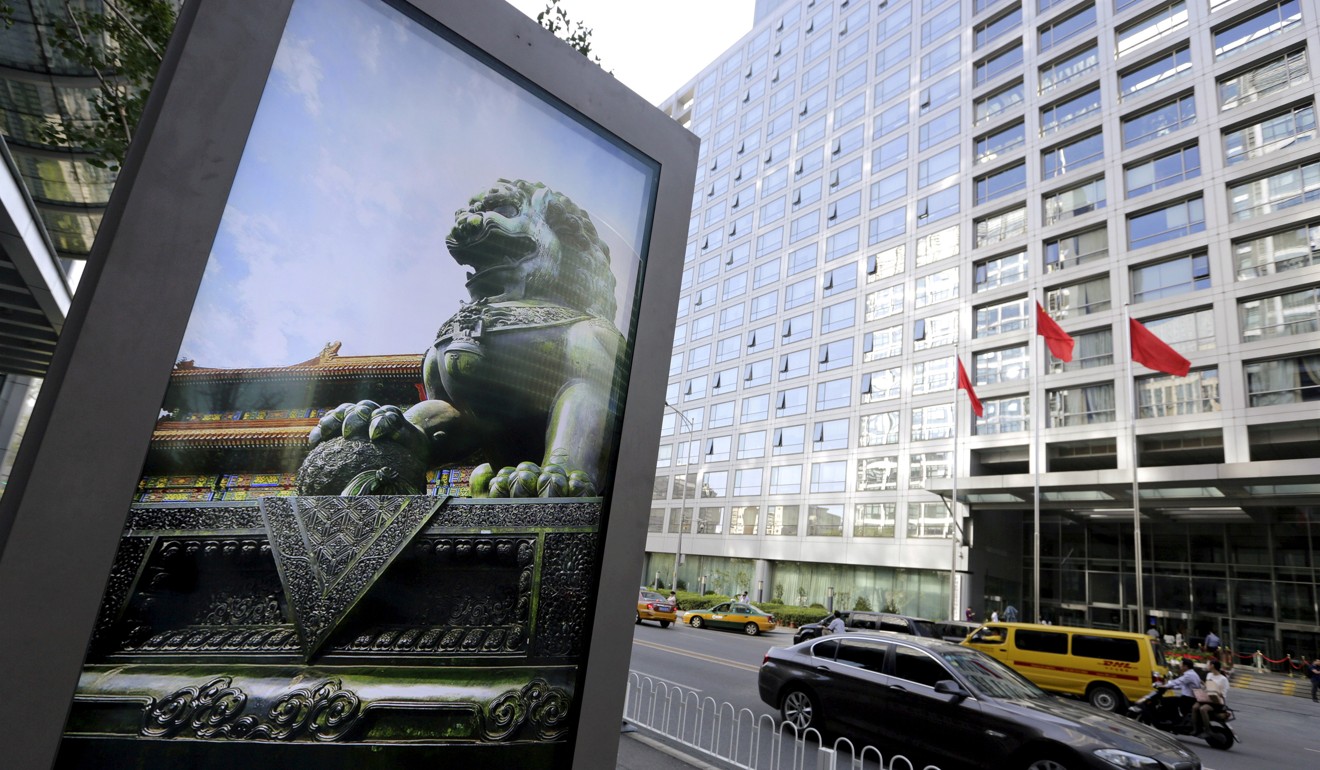
Why the US-China trade war complicates Beijing’s response to the market crash
- Government support for the stock market may need to continue for some time for it to avoid further drops in prices, because of the escalating US-China trade war
The Chinese government has been far less interventionist in its effort to bolster the stock market recently, when compared with steps taken to contain a market meltdown in 2015.
And because the situation is dominated by an external threat this time – the US-China trade war – Beijing may have to accept the outcome of slowing economic growth, which will continue to put downward pressure on domestic stocks, analysts have said. This means the market will remain volatile for some time, and the government’s support will need to remain in place for an extended period.
China’s stocks fall to 4-year low amid fears of forced selling
It is not yet clear if the steps taken by the government so far have been successful in preventing this year’s market slide from turning into a bigger systemic crisis throughout the Chinese financial system.
Supportive comments by top government officials and stock buying by several government-linked funds helped the Shanghai Composite Index rise by 2.6 per cent on Friday and another 4.1 per cent on Monday, but much of these gains were erased after a loss of 3.3 per cent in the following three days. And a rout in technology stocks on Wall Street on Wednesday, which wiped out all US market gains for the year, is making stock investors worldwide increasingly nervous.
But Beijing appears to have learned from mistakes made during the 2015 market crisis. It is avoiding heavy handed and ill-thought out intervention, which backfired, scuttling its ambitions of having its shares included in major international stock indices at the time.
The 2015 crisis
In the summer of 2015, the Chinese authorities took drastic action to halt a stock market rout and contain the outbreak of financial risks that threatened the entire financial system. A “national team” of state-controlled financial companies was formed to bail out the market. The team was led by China Securities Finance Corporation, which injected funds into brokerages, while sovereign wealth fund subsidiary Central Huijin Investment bought shares of blue chips as well as smaller companies. The stock regulator banned major shareholders from selling their shares. Short-sellers and journalists were detained and questioned as part of an official inquiry into market volatility.
Analysts have estimated that 1.5 trillion yuan (US$216 billion) of government funds were used for the bailout.
China’s plan to cut debt, ensure efficient capital may be mission impossible in a slower economy
At the centre of the 2015 crisis was an explosion of shadow-banking and margin-financing activity as the ruling Communist Party tried to use the equity market to bolster the finances of state-owned companies. Margin financing, in which brokerages lend money to clients to invest in stocks or other securities, came with high risks to the financial system and was eventually curtailed by tighter rules, which triggered panic selling and a market meltdown. The result of the government crackdown created another of China’s well-known boom-and-bust market cycles.

The stock market is dominated by state-owned companies with valuations often heavily influenced by government policies and liquidity conditions, rather than the success of their corporate decisions and operations.
The doubling of the Shanghai Composite Index in the year to June 2015 was followed by a loss of half of the market’s value in the next seven months. Hong Kong’s benchmark Hang Seng Index suffered one of its biggest point drops on record, erasing all its gains over the previous 12 months.
The 2018 Crisis
Beijing is currently using a mix of light intervention in the stock market and modest monetary and fiscal stimulus to cushion growth amid its trade war with the United States.
On Friday and over the weekend, Chinese President Xi Jinping, Vice-Premier Liu He and the heads of the People’s Bank of China, the China Securities Regulatory Commission and the China Banking and Insurance Regulatory Commission praised undervalued stocks while promising a series of new measures to aid struggling private businesses. The central bank boosted its relending and rediscount quotas by 150 billion yuan to help the financing needs of small enterprises. Another round of tax cuts may be considered for next year after the modest ones announced in August.
Top China adviser tries to boost battered confidence in economy after weak stocks, financial data
Members of the national team this time come from smaller state investment and pension funds, real estate and security brokers as well as state-owned banks, but there has been no massive national stock buying scheme, analysts said.
The stock regulator has also avoided an increase in A-share suspensions to contain market volatility so far. In contrast, trading in more than half of China’s 3,000-plus listed companies was halted at the height of the 2015 stock market crash.
Pledged collateral and an external threat
It is worth keeping in mind that the dovish policy adopted so far this year comes in response to a relatively smaller decline of 30 per cent in the Shanghai Composite Index over the past nine months, after a similarly small sized gain between 2016 and January 2018. This round of reflation was fuelled in large part by major shareholders of Chinese companies and investors pledging their stock to obtain loans for personal or business purposes, because they often do not qualify for regular bank loans.
As the stock market falls, so does the value of the collateral, prompting banks to demand additional funds. Investors are concerned that forced sales of stock to meet these demands would create a vicious downward spiral in the stock market.
Gao Ting, head of China strategy at UBS Securities, estimated that as much as 4.2 trillion yuan (US$605 billion) in A-share market cap was pledged as collateral. Of this, about 800 billion yuan to 900 billion yuan was near the forced liquidation line, which is equivalent to 2 per cent of overall A-share market cap and 5 per cent of free-floating market cap.

That is below the 5 trillion yuan in margin financing that was outstanding at the height of the 2015 market crash, before being liquidated to around 1.5 trillion as the crash wound down, according to Gao.
Also, in 2015 China was able to swiftly address financial system risks because they were domestic in origin. This time around, it is facing external forces that are more difficult to manage. The trade war with the US is likely to be a drawn out affair, creating inevitable downside risks for the market and the economy.
“The 2015 market fall was induced by domestic policy and reforms. It’s different this time because it is an external problem and will largely depend on how China reacts to US tariffs,” said Iris Pang, Greater China economist at ING Bank in Hong Kong. “This time round, the state funds may need to hold on to their loss positions [in stocks] for a longer period of time.”
Lack of reform, the temptation of intervention
The market and policy measures enacted by the government so far have led to questions about its ability to proceed with the market liberalisation and reform of state-owned enterprises that many analysts say are crucial to solving the underlying problems behind the weakness in the economy and the stock market. Exercising excessive party control could discourage the entry of private capital and interfere with enterprises’ commercial operations.
Similarly, will Beijing resist the temptation to go large with economic support, much like the massive stimulus measures it enacted during the global financial crisis a decade ago? Headwinds in the coming months and years may have made Beijing realise it needs to make the economy more of a priority, halting its efforts towards deleveraging financial risks after years of cheap money and loosening lending practises.
Will Beijing accept lower growth?
Steven Cochrane, chief Asia-Pacific economist at Moody’s Analytics, said any resistance by Beijing in accepting slower growth carries risks, particularly given the rapid rise in debt since the global financial crisis.
“Should Beijing continue to resist slower growth by reverting to its old debt-fuelled growth model, risks will continue to build, leaving China more vulnerable to unforeseen shocks,” said Cochrane.
China’s total debt to nominal gross domestic product stands at 260 per cent, up from 143 per cent in 2008, according to the Bank for International Settlements.
A major drag on stock market sentiment has been the rising number of bond defaults by Chinese companies this year, as part of the government’s deleveraging drive, which has led to bankruptcies and stress for the financial system.
Should Beijing continue to resist slower growth by reverting to its old debt-fuelled growth model, risks will continue to build
China’s corporate bond market is hugely mispriced because yields have been artificially depressed by implicit government guarantees extended to weak, zombie state-owned companies. So rising defaults in the credit market could be deemed a healthy development in an effort to cut back on moral hazard.
The Chinese central bank is also keeping a relatively loose monetary policy stance in an effort to maintain a controlled, gradual pace of corporate bond defaults.
But if the risk is not carefully managed and the pace of defaults picks up more than expected, because of the negative impact from the trade war, it may cause a snowball effect in stock liquidations, and the contagion could spread to currencies and stock markets in other parts of the world.
“There is a huge mispricing problem in China’s credit so if there was a severe adjustment it may very well come from that area,” said Cliff Tan, east Asian head of global markets research at MUFG. “What would make [market volatility] global is if you had some big boulder rolling into this environment, and China could be that big boulder.”
As it is, there are widespread expectations that Chinese growth will slow next year, and that is likely to lead to asset quality problems for commercial banks given China’s debt load, said Tan.
Goldman Sachs forecasts policymakers will adjust down their growth target for next year to a range of 6.0 per cent to 6.5 per cent from the target of around 6.5 per cent for this year.

